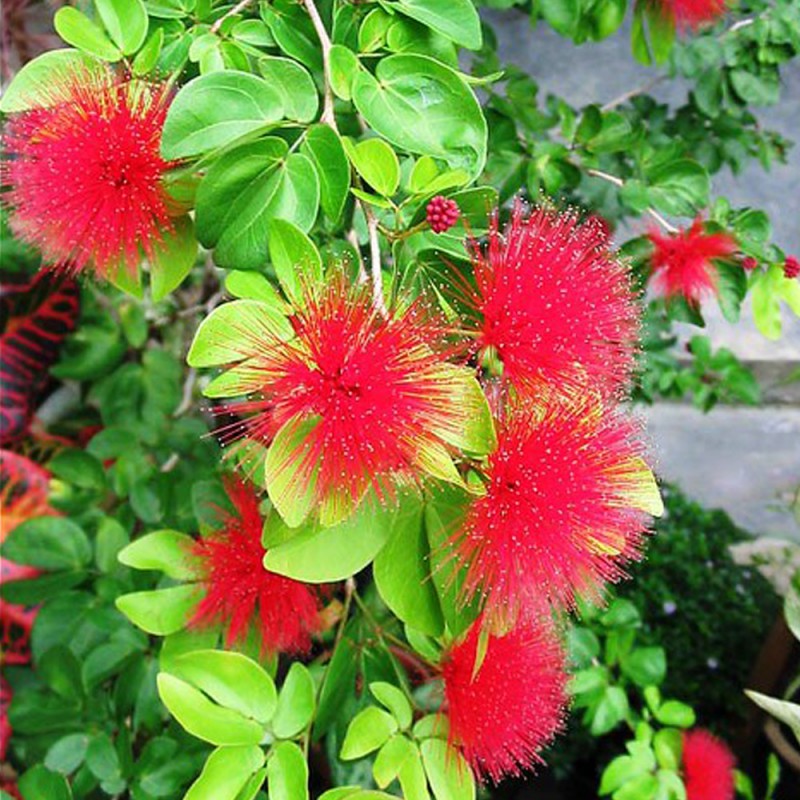

The Calliandra Tree, also known as the Pink Powderpuff Tree, is a botanical marvel that adds beauty and vibrancy wherever it grows. With its striking pink flowers, delicate fern-like leaves, and ecological significance, this tree is more than ju Read more
Trending
Trees for Corporates
Calliandra Tree: The Stunning Pink Powderpuff Transforming Gardens, Ec
You may also like
Corporate Plantations
Calliandra Tree Uses
The Calliandra Tree is a multitasking marvel, perfect for creating vibrant landscapes, feeding pollinators, and improving soil fertility. It’s nature’s way of blending beauty and function seamlessly.
Calliandra Tree Benefits
Beyond its striking pink blooms, this tree is a champion for biodiversity, offering shade, nitrogen-rich soil, and a splash of color that makes every garden pop.
Calliandra Tree Cultivation
Cultivating a Calliandra Tree is like planting a bouquet that keeps on giving. It thrives in tropical climates, loves sunlight, and rewards you with low-maintenance charm.
Calliandra Tree Flowers
These powderpuff-like blossoms aren’t just pretty—they’re magnets for bees, butterflies, and birds, making your garden a bustling hub of activity.
Calliandra Tree for Soil Health
Its nitrogen-fixing roots enrich the soil, making it a sustainable choice for agroforestry and a perfect companion for other plants.
Calliandra Tree in Ecosystems
This tree is a biodiversity booster, providing food, shelter, and habitat for countless species while contributing to ecological balance.
Calliandra Tree Growth Conditions
Sun-loving and drought-tolerant, the Calliandra Tree thrives in sandy, well-drained soils, proving that beauty doesn’t have to be high-maintenance.
Calliandra Tree Environmental Impact
It’s an eco-warrior, fighting erosion, improving air quality, and supporting pollinators—all while looking like a tropical fireworks display.
Calliandra Tree as a Pollinator Magnet
With blooms that attract bees, butterflies, and hummingbirds, this tree turns your garden into a pollinator paradise and ensures your plants flourish.
Calliandra Tree for Ornamental Landscaping
Its stunning pink flowers and lush greenery make it a standout choice for beautifying parks, streets, and private gardens alike.
Calliandra Tree History
Originating in Central and South America, this tree has traveled the world, earning admiration for its striking appearance and ecological benefits.
Calliandra Tree in Agroforestry
This tree is a farmer’s friend, improving crop yields with its nitrogen-fixing roots while providing fodder, fuel, and shade—a true workhorse in disguise.
FAQ
What is the Calliandra Tree?
It’s a tropical showstopper with pink powderpuff blooms that brighten gardens, enrich ecosystems, and attract pollinators—a true beauty with a purpose.
Why is the Calliandra Tree called a powderpuff tree?
Its fluffy, vibrant blossoms resemble delicate powderpuffs, making it one of the most charming trees in ornamental landscaping.
What are the benefits of the Calliandra Tree?
It enhances soil fertility, supports biodiversity, provides shade, and turns any garden into a vibrant, pollinator-friendly paradise.
Can I grow a Calliandra Tree at home?
Yes! It’s low-maintenance, sun-loving, and perfect for adding color and ecological benefits to your backyard or garden.
What does the Calliandra Tree attract?
Its flowers are a magnet for bees, butterflies, and hummingbirds, creating a lively, buzzing garden scene year-round.
What are the environmental benefits of the Calliandra Tree?
It fights erosion, fixes nitrogen in soil, improves air quality, and supports pollinator populations, making it an ecological hero.
Where does the Calliandra Tree grow best?
This tropical gem thrives in sunny, warm climates with well-drained soil, making it ideal for gardens, parks, and agroforestry.
What are the Calliandra Tree’s growth requirements?
It loves sunlight, tolerates drought, and adapts to a variety of soils, proving that beauty doesn’t always demand pampering.
How is the Calliandra Tree used in agroforestry?
Its nitrogen-fixing roots improve soil for crops, while its leaves provide fodder, and its shade offers relief for farmers and livestock.
What makes the Calliandra Tree eco-friendly?
From enriching soil to supporting pollinators and fighting erosion, this tree is a green powerhouse with a flair for style.
How do you care for a Calliandra Tree?
Just give it sunlight, occasional watering, and well-drained soil, and it’ll reward you with blooms and ecological benefits galore.
What is the history of the Calliandra Tree?
Native to the Americas, this tree has captivated the world with its stunning flowers and eco-friendly versatility, earning a global fanbase.
Most Popular
Connect with us
-
👥 Corporates
If you are looking for:
- 🌲 Tree Plantation Events
- 📊 CSR Projects
📧 corporate@growbilliontrees.com
📞 +91 9699723523
💬 +91 9325931304 WhatsApp (Only)
🕒 Mon - Sat | 10am - 7pm IST
-
🧩 Tree Plantation NGOs
If you are looking for:
- 💰 Financial Assistance
- 🤝 Operational Support
📧 support@growbilliontrees.com
📞 +91 9699723523
💬 +91 9325931304 WhatsApp (Only)
🕒 Mon - Sat | 10am - 7pm IST
-
🌼 Individuals
If you are looking for:
- 👥 Group Tree Plantation Drive
- 🌳 Bulk Tree Plantation
📞 +91 9699723523
💬 +91 9325931304 WhatsApp (Only)
🕒 Mon - Sat | 10am - 7pm IST





















